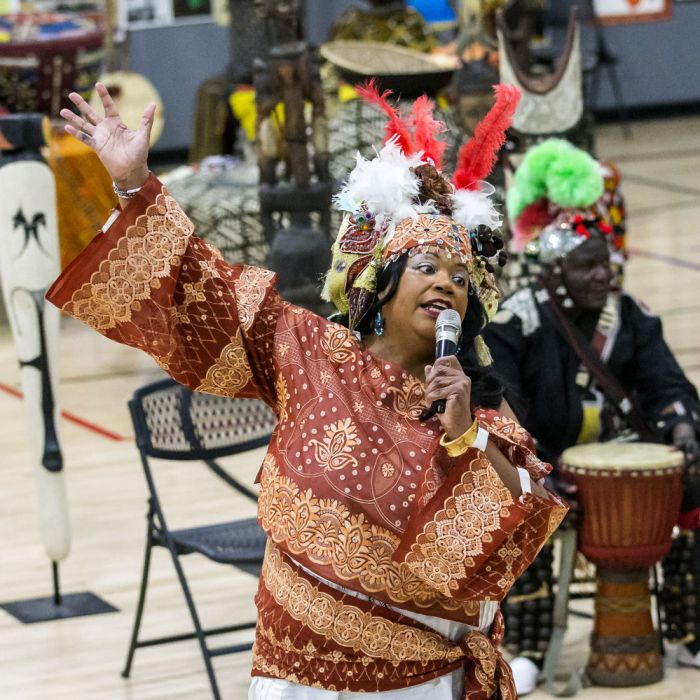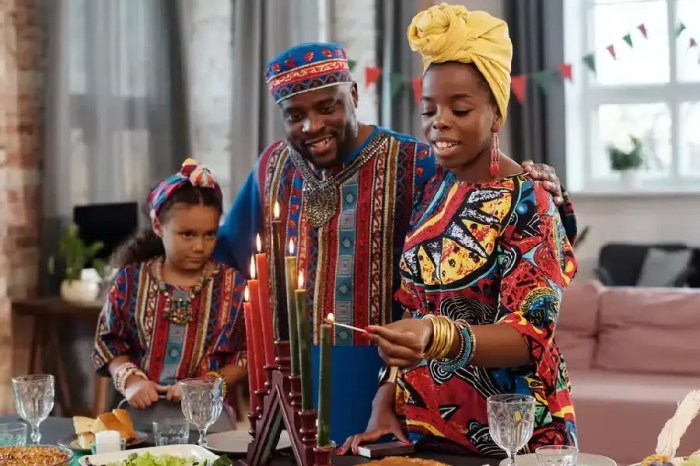Kwanzaa Trivia Questions and Answers: Embark on an enlightening journey into the vibrant tapestry of Kwanzaa, a holiday steeped in African American heritage and cultural significance. This comprehensive guide unravels the rich history, principles, symbols, and modern-day relevance of Kwanzaa, offering a captivating exploration into its origins, traditions, and profound impact.
From its inception by Dr. Maulana Karenga in 1966 to its widespread adoption as a symbol of African American unity and identity, Kwanzaa has evolved into a cherished celebration that embodies the Nguzo Saba (Seven Principles) and fosters a sense of community and cultural pride.
Kwanzaa Origins and History

Kwanzaa, an African-American cultural holiday, was created in 1966 by Dr. Maulana Karenga. It is celebrated annually from December 26 to January 1.
Kwanzaa was developed as a way to honor African heritage and promote unity within the African-American community. It is based on the Nguzo Saba, or Seven Principles of Kwanzaa, which are: Umoja (Unity), Kujichagulia (Self-Determination), Ujima (Collective Work and Responsibility), Ujamaa (Cooperative Economics), Nia (Purpose), Kuumba (Creativity), and Imani (Faith).
Founder of Kwanzaa
Dr. Maulana Karenga, born Ronald McKinley Everett, was a prominent African-American activist and scholar. He founded Kwanzaa as a way to celebrate African-American culture and promote unity within the community.
Cultural and Social Context
Kwanzaa emerged during a time of significant social and cultural change in the United States. The Civil Rights Movement had gained momentum, and there was a growing awareness of African-American history and culture.
Kwanzaa provided a way for African-Americans to connect with their heritage and celebrate their identity. It also served as a reminder of the importance of unity and collective action in the face of challenges.
Kwanzaa Principles and Symbols

Kwanzaa, an African-American holiday, celebrates African heritage and culture. Its principles and symbols hold deep significance and serve as a reminder of the holiday’s purpose.
Seven Principles of Kwanzaa (Nguzo Saba)
The seven principles, known as the Nguzo Saba, are the core values that guide Kwanzaa celebrations:
- Umoja (Unity):Fostering a sense of togetherness and cooperation within the community.
- Kujichagulia (Self-Determination):Empowering individuals to make their own choices and shape their destiny.
- Ujima (Collective Work and Responsibility):Working together to improve the community and uplift each other.
- Ujamaa (Cooperative Economics):Supporting and investing in community businesses and economic development.
- Nia (Purpose):Setting goals and working towards a better future.
- Kuumba (Creativity):Expressing oneself through art, music, and other creative endeavors.
- Imani (Faith):Believing in oneself, the community, and a higher power.
Kinara and Candles
The kinara, a seven-candlestick holder, is a central symbol of Kwanzaa. It represents the seven principles and the seven days of the holiday. Each day, a candle is lit, starting with the black candle in the center and then alternating between three red candles on the left and three green candles on the right.
The black candle symbolizes the African people, the red candles represent the blood shed in the struggle for freedom, and the green candles signify the hope and prosperity of the future.
Colors, Shapes, and Materials
The colors, shapes, and materials used in Kwanzaa decorations also carry symbolic meaning:
- Black:Represents the African people and their ancestors.
- Red:Symbolizes the blood shed in the struggle for freedom and liberation.
- Green:Signifies hope, growth, and prosperity.
- Circle:Represents unity and community.
- Natural materials:Such as wood and raffia, connect Kwanzaa to its African roots.
Kwanzaa Celebrations: Kwanzaa Trivia Questions And Answers

Kwanzaa celebrations typically take place over seven days, with each day dedicated to one of the seven principles of Kwanzaa. The celebrations include a variety of rituals and ceremonies, culminating in a feast called the karamu on the final day.
Day-by-Day Guide to Kwanzaa Celebrations
The following is a step-by-step guide to traditional Kwanzaa celebrations:
- Day 1: Umoja (Unity):On the first day of Kwanzaa, families and communities gather to light the first candle on the kinara, the seven-branched candelabra. The candle represents the principle of unity, and the ceremony often includes readings, songs, and prayers.
- Day 2: Kujichagulia (Self-Determination):On the second day, the second candle is lit, representing the principle of self-determination. This day is often dedicated to discussions about African history and culture, and ways to promote self-reliance.
- Day 3: Ujima (Collective Work and Responsibility):On the third day, the third candle is lit, representing the principle of collective work and responsibility. This day is often dedicated to community service projects and discussions about how to work together to improve the community.
- Day 4: Ujamaa (Cooperative Economics):On the fourth day, the fourth candle is lit, representing the principle of cooperative economics. This day is often dedicated to discussions about economic empowerment and how to support black-owned businesses.
- Day 5: Nia (Purpose):On the fifth day, the fifth candle is lit, representing the principle of purpose. This day is often dedicated to discussions about the importance of having a sense of purpose in life and how to find it.
- Day 6: Kuumba (Creativity):On the sixth day, the sixth candle is lit, representing the principle of creativity. This day is often dedicated to artistic expression and creativity, and people often engage in activities such as painting, dancing, or writing.
- Day 7: Imani (Faith):On the seventh and final day of Kwanzaa, the seventh candle is lit, representing the principle of faith. This day is often dedicated to discussions about the importance of faith and spirituality, and the ceremony often includes readings, songs, and prayers.
The Karamu
The karamu is a feast held on the final day of Kwanzaa. It is a time for families and communities to come together and celebrate the holiday. The feast typically includes traditional African dishes, such as black-eyed peas, collard greens, and cornbread.
The karamu is also a time for reflection and sharing of stories, and it is a way to bring the Kwanzaa celebration to a close.
Kwanzaa in Modern Times

Kwanzaa has undergone significant evolution since its inception in 1966. Over time, it has gained widespread recognition and has become an important cultural and spiritual practice for many African Americans.
Kwanzaa has been adapted and celebrated in diverse communities, reflecting the rich tapestry of African American experiences. In urban areas, Kwanzaa celebrations often take place in community centers, churches, and schools, bringing together families and neighbors to share in the traditions and values of the holiday.
Spread and Adaptation
The spread of Kwanzaa beyond its initial base in Los Angeles is attributed to several factors. The growing awareness of African American history and culture during the 1960s and 1970s contributed to the holiday’s popularity. Additionally, the efforts of Maulana Karenga and other activists to promote Kwanzaa played a significant role in its dissemination.
As Kwanzaa spread, it was adapted to reflect the specific needs and experiences of different communities. In some areas, the holiday took on a more political and activist orientation, while in others, it remained primarily a cultural and spiritual celebration.
Impact on African American Culture and Identity, Kwanzaa trivia questions and answers
Kwanzaa has had a profound impact on African American culture and identity. The holiday provides a sense of continuity and connection to African heritage, while also celebrating the unique experiences and achievements of African Americans in the United States.
Kwanzaa has also contributed to the development of a more positive and self-affirming African American identity. By emphasizing the principles of unity, self-determination, and collective work, Kwanzaa encourages African Americans to embrace their history, culture, and values.
Kwanzaa Trivia Questions and Answers

Kwanzaa, a seven-day celebration honoring African heritage and culture, is rich in symbolism and tradition. Test your knowledge of this meaningful holiday with the following trivia questions and answers.
Kwanzaa Origins and History
- Who created Kwanzaa?
Maulana Karenga, an African-American scholar and activist
- When was Kwanzaa first celebrated?
December 26, 1966
- What inspired the creation of Kwanzaa?
The desire to connect African Americans with their African roots and celebrate their cultural heritage
Essential Questionnaire
What is the origin of Kwanzaa?
Kwanzaa was created in 1966 by Dr. Maulana Karenga as a way to celebrate African American heritage and culture during the holiday season.
What are the seven principles of Kwanzaa?
The seven principles of Kwanzaa, known as the Nguzo Saba, are unity, self-determination, collective work and responsibility, cooperative economics, purpose, creativity, and faith.
What is the significance of the kinara?
The kinara is a seven-candle holder that represents the seven principles of Kwanzaa. The candles are lit one by one each day of Kwanzaa, starting with the black candle in the center on the first day.
What is the karamu?
The karamu is a feast held on the final day of Kwanzaa. It is a time for family and friends to gather and celebrate the holiday with food, music, and dance.